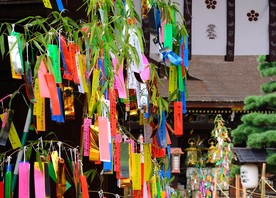
Intro
Spring is almost here and it’s arguably the most popular season to visit Japan. The country has had record visitors over the last year and tourists remain enchanted by the country’s temples and shrines. In fact, our research shows that Google searches for Fushimi Inari shrine, as an example, went up 140% recently, which goes to show that interest in the country’s sacred sites is at an all-time high. To help you make the most of your visit, here at JRPass.com, we have created a list of essential tips for exploring Japan’s most searched for and in-demand shrines and temples in springtime.Most popular temples and shrines

Renowned for its striking path of over 1,000 vibrant red torii gates that wind up the mountainside, the shrine is dedicated to Inari, the revered deity of rice and prosperity. The temple exudes a tranquil yet powerful aura. For the best experience, visit in the early morning or late evening, when soft light filters through the gates and the crowds have cleared.
Sensoji, Tokyo’s oldest temple, attracts 12,000 global monthly searches and stands as a stunning tribute to Japan’s rich cultural heritage.

Located in the vibrant Asakusa district, this Buddhist temple is dedicated to Kannon, the goddess of mercy, and is famous for its dramatic Kaminarimon (Thunder Gate), adorned with a giant red lantern. Beyond the bustling Nakamise shopping street lies the temple’s grand main hall and five-story pagoda. For a peaceful experience, visit at dawn or enjoy the temple beautifully illuminated at night. 
Kinkakuji, or the Golden Pavilion, boasts 32,000 global monthly searches and is a breathtaking Zen temple in Kyoto. Its gold leaf-covered walls gleam, reflecting elegantly in the tranquil pond that surrounds it. Originally built as a shogun’s retirement villa, it is now a symbol of harmony and refined beauty, nestled amid meticulously landscaped gardens. Each season brings a unique charm, from the lush greenery of summer to the snow-dusted serenity of winter. For the best experience, visit early in the morning to fully savour the peaceful ambiance and the stunning interplay of light on the temple.
What to expect when visiting
Many temples, like Todai-ji in Nara, are home to the towering Great Buddha statue. Iconic shrines such as Itsukushima Shrine on Miyajima Island are famous for their "floating" torii gate. Both offer a serene escape from Japan's bustling cities.
Expect intricate wooden architecture with ornate carvings, serene Zen gardens for meditation, and wild deer roaming freely in places like Nara, seen as sacred messengers of the gods. Visitors can buy omamori (amulets) from shrine stalls for blessings like health, love, success, or protection, making for meaningful keepsakes.
Visitors can also participate in traditions by purchasing omamori (amulets) from shrine stalls, each designed to provide specific blessings.
How to Respectfully Participate in Rituals
Before entering a shrine or temple, visitors should stop at the purification fountain (Chōzuya) to cleanse themselves. Using a ladle, pour water over your left hand, then your right, and rinse your mouth, spitting discreetly before cleaning the ladle handle. Just remember to pour the water into your hand rather than drinking directly from the ladle.
When offering a prayer, the ritual differs slightly between shrines and temples. At shrines, bow twice, clap twice, and bow once more before praying. At temples, a simple bow and silent reflection are customary. Before praying, it’s traditional to toss a small coin into the offering box.
Many visitors choose to leave a wish behind by writing on an ema, a small wooden plaque available at shrine stores, and hanging it on a rack. Wishes can range from health and success to personal goals.
Lighting incense (senko) is another common practice at temples. Visitors can purchase incense sticks, light them, and let them burn briefly as an offering before prayer, adding to the tranquil and sacred atmosphere.
Bonus Recommendations
- First time in Japan for work? Try our Meet and Greet Service for expert help on arrival. It’s like having a personal assistant at the airport after you land.
- If you’re looking for work, you’re going to want to stay connected. Invest in a PocketWifi device to ensure you’re online wherever you go.
- For more on temples and shrines, as well as traditional Japanese customs, rituals, and spiritual beliefs, be sure to check out our blog page, which has a wealth of articles on these subjects for you to read.





